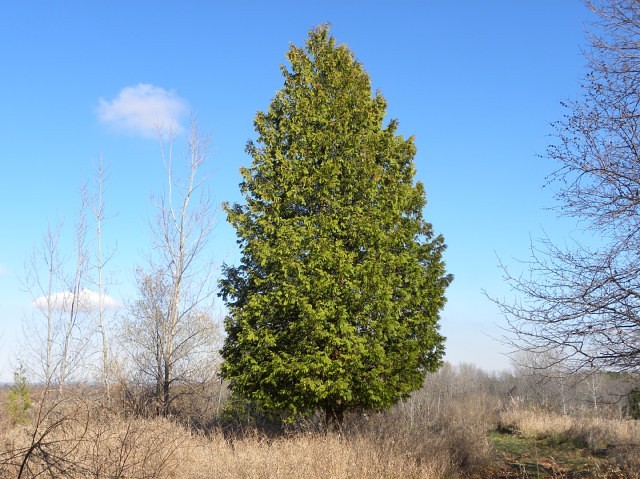Our Favorite Ornamental Trees to Grow in Virginia
Any gardener knows that ornamental trees are essential for adding color and life to a garden. But beyond their aesthetic value, ornamental trees also play an important role in the health of a garden ecosystem. By attracting pollinators like bees and butterflies, they help to ensure that other plants receive the pollen they need to reproduce. They can also help to improve the soil by releasing nutrients into the ground. When selecting ornamental trees for your garden, it is important to choose species native to your region. This will ensure that the plants are well-adapted to your local climate and soil conditions. Additionally, native plants are more likely to support local wildlife populations. Here are the best ornamental trees for your Virginia garden:
Flowering Cherry (Prunus serrulata)

The flowering cherry (Prunus serrulata) is a popular ornamental tree prized for its delicate blossoms and pretty foliage. It is native to China and Japan and has been cultivated for centuries. These days, it is grown worldwide in large and small gardens. Growing a flowering cherry is relatively easy, and even beginner gardeners can enjoy success with this lovely tree.
The flowering cherry typically grows to a height of 15-20 feet, with a spread of 12-15 feet. It has a rounded crown and produces small, white flowers in springtime. Once the flowers with they are followed by oval-shaped, dark green leaves, which turn yellow or reddish in autumn. The tree’s bark is smooth and brown, with a slightly mottled appearance.
When selecting a spot to plant your flowering cherry, choose an area that receives full sun. The soil should be well-drained and fertile, with a pH of 6.5-7.0. Add compost or manure to the planting hole to improve drainage and enrich the soil. During the early period, the tree needs to be watered to establish the root system. Once the tree is established, it is relatively drought-tolerant. Fertilize in early spring using a general-purpose fertilizer formulated for trees and shrubs. Prune as needed after blooming to remove dead or damaged branches, thin out overcrowded areas, or shape the tree as desired.
Carolina Silverbell (Halesia carolina)
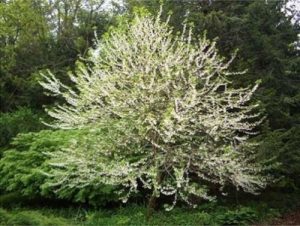
The Carolina silverbell (Halesia carolina) is a tree native to the southeastern United States. It typically grows to 15-20 feet and has a crown of delicate, white flowers. The flowers bloom from April to May. These flowers attract bees, birds, and butterflies, making the Carolina Silverbell an excellent choice for wildlife gardens. The leaves are oval-shaped and have a silvery sheen, which gives the tree its common name. The Carolina silverbell is an excellent ornamental plant for small gardens or yards. It is tolerant to several soil types and can grow in full sun or partial shade. Additionally, it is relatively pest- and disease-free. The Carolina silverbell is ideal for gardeners looking for a low-maintenance tree with beautiful flowers.
Yuletide Camellias (Camellia sasanqua)
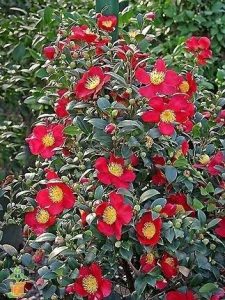
Camellia sasanqua, also known as Yuletide Camellias, is a species of Camellia that is native to southern Japan and southern Korea. The plant is an evergreen shrub that can grow to heights of 10 feet (3 meters) with a spread of 6 feet (1.8 meters). The leaves are glossy and dark green, and the flowers are white or pink and bloom from October to December. Yuletide Camellias are relatively easy to care for and make an excellent addition to any garden.
The plants prefer a sunny location with well-drained soil. They are tolerant of a wide range of soils, including clay, sand, and loam. However, they will not tolerate wet or waterlogged conditions. Once established, Yuletide Camellias are drought tolerant and only need occasional watering during periods of extended dry weather.
Fertilize the plants in early spring with a balanced fertilizer such as 10-10-10. Apply the fertilizer according to the manufacturer’s instructions. Prune the plants after they have finished flowering in late winter or early spring. Cut back any dead or damaged branches and trim the plants to shape them as desired. Yuletide Camellias can also be grown in containers. Choose a pot that is at least 18 inches (45 cm) wide and has drainage holes in the bottom. Fill the pot with a well-drained potting mix such as two parts peat moss to 1 part perlite or vermiculite. Water the plant regularly and fertilize it every two weeks during the growing season.
Dynamite Crape Myrtle (Lagerstroemia indica)
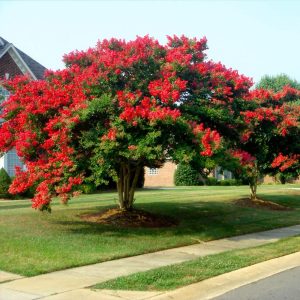
The Dynamite Crape Myrtle (Lagerstroemia indica) is a versatile and easy-to-grow ornamental plant that blooms profusely from late spring to early fall. The Dynamite Crape Myrtle is a deciduous shrub that typically grows 6-12 feet tall and wide, with a dense, rounded form. It has glossy, dark green leaves that turn yellow, red, or purple in the fall. The plant’s most striking feature is its abundant clusters of bright pink flowers that appear in late spring or early summer and last for several weeks. The Dynamite Crape Myrtle is tolerant of a variety of soil types and prefers full sun, making it an ideal plant for use in landscape beds, foundation plantings, or as a specimen plant. With its showy flowers and attractive foliage, the Dynamite Crape Myrtle is sure to add beauty to any garden.
Japanese Snowbell (Styrax japonicus)
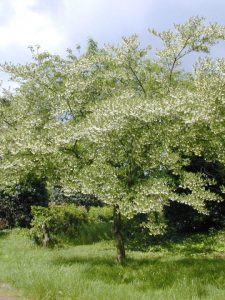
The Japanese Snowbell (Styrax japonicus) is a small, ornamental tree native to Asian countries. It is often grown in gardens and parks and prized for its beautiful bell-shaped flowers that bloom in early summer. The flowers are white or pale pink, followed by small round fruits that turn black when ripe. The leaves of the Japanese Snowbell are oval-shaped and dark green, with a silvery-white underside. The tree will grow to a height of 6-8 feet and has a slender, upright growth habit. Japanese Snowbells are easy to care for and do not require much pruning or training. They are also tolerant to many soil types and growing conditions. The Japanese Snowbell is excellent for gardens and landscapes due to its attractive foliage and bell-like flowers. It is also a relatively low-maintenance tree, requiring little pruning or fertilizer. Additionally, the Japanese Snowbell is tolerant of both full sun and partial shade.
Sourwood (Oxydendrum arboreum)

Sourwood (Oxydendrum arboreum) is a tree that is native to the eastern United States. It reaches a height of 15-25 feet, with a spreading crown. The leaves are oblong, 2-6 inches long, with a sour taste when chewed. The flowers are small and white, arranged in clusters at the ends of the branches. The fruits are small, black berries that ripen in late summer or early fall. Sourwood is typically planted as an ornamental tree, but it can also be used for making honey and woodcrafts. To grow sourwood, choose a site with full sun and well-drained soil. The tree is tolerant of a wide range of soils but grows best in sandy or loamy soils. It can be propagated by seed or cuttings. Seedlings should be planted in the spring, while cuttings can be taken from young shoots in the summer. Once established, sourwood is relatively drought tolerant and does not require much maintenance. However, it does benefit from occasional pruning to maintain its shape. Overall, sourwood is an easy-to-grow tree that adds ornamental value to the landscape.
Natchez Crape Myrtle (Lagerstroemia x natchez)
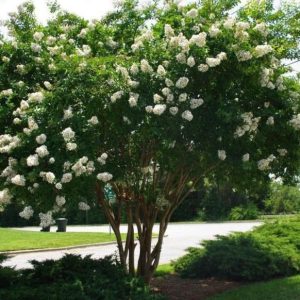
The Natchez Crape Myrtle (Lagerstroemia x natchez) is a deciduous shrub or small tree that is native to the southeastern United States. It is a hybrid of L. indica and L. fauriei, and it was first cultivated in Natchez, Mississippi. The Natchez Crape Myrtle typically grows to a height of 15-25 feet, with a spread of 10-20 feet. It has a rounded crown and an upright, spreading growth habit. The leaves are oblong-lanceolate, 2-6 inches long, and green in color. The flowers are pink or white, papery, and clustered. The Natchez Crape Myrtle blooms from June to September. The fruit is globose drupe, 0.5-1 inch in diameter, that ripens from red to black in late summer or early fall. The Natchez Crape Myrtle is tolerant of a wide range of soils and climate conditions and is resistant to drought, heat, pests, and disease. It is good for landscaping, as it provides year-round interest with its showy flowers, beautiful foliage, and attractive form.
Higan Cherry (Prunus subhirtella var. autumnalis)

The Higan Cherry, also known as the Autumn Cherry, is a species of flowering cherry native to Japan. It is a small deciduous tree that typically grows to a height of 10-15 feet, with a spreading canopy of 20-30 feet. The leaves are oval-shaped, dark green, and glossy, with sharply serrated edges. The white or pink flowers appear in clusters of 2-5 blossoms. The fruit is a small black cherry, which ripens in late summer or early autumn. Higan Cherry trees are widely cultivated as ornamental trees due to their attractive foliage, flowers, and fruit. They are also popular as Bonsai specimens. Additionally, the wood of the Higan Cherry is prized for its beautiful grain and hardness, making it a sought-after material for woodworking. The Higan Cherry is adaptable to a wide range of climates and soils and is relatively disease-resistant. As a result, it is an ideal choice for those looking for an ornamental tree that is easy to care for.
Yoshino Cherry (Prunus x yedoensis)
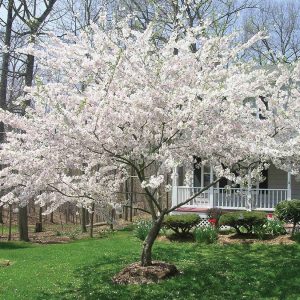
The Yoshino Cherry (Prunus x yedoensis) is a hybrid cultivar of the Somei-Yoshino Cherry (Prunus speciosa) and the Edo Higan Cherry (Prunus incisa). It was first cultivated in Japan in the late 19th century and has since become one of the world’s most popular ornamental cherry trees. The Yoshino Cherry is characterized by its delicate white flowers that bloom in early spring before the leaves emerge. The tree typically reaches a height of 10-15 meters and has a rounded canopy with dense foliage. The branches are covered in smooth, dark bark, and the leaves are ovate-shaped and dark green. The Yoshino Cherry is a hardy tree that tolerates a range of environmental conditions, making it an ideal choice for homeowners and landscapers alike. In addition to its beauty, the Yoshino Cherry is also prized for its environmental benefits. The tree helps improve air quality by absorbing pollutants such as carbon dioxide and providing shelter and food for wildlife.
Hawthorn (Crataegus spp.)
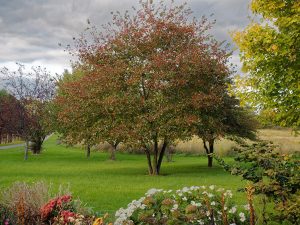
Hawthorn (Crataegus spp.) is a deciduous shrub or small tree that is native to Europe, Asia, and North America. It has been widely planted as an ornamental plant due to its hardiness and attractive spring flowers. Hawthorn grows to 15-20 feet and has dark green foliage. The flowers are white or pink and are followed by small red fruits. The fruit is poisonous to humans but is attractive to birds. Hawthorn can be grown in a variety of soil types but prefers well-drained soil. It is drought tolerant and can tolerate periods of flooding. It is also salt tolerant, making it a good choice for planting near roadsides where de-icing salts are used in winter. Hawthorn is relatively disease and pest-resistant. It can be attacked by aphids, scale, and spider mites, but these pests are usually not detrimental to the health of the plant. Overall, the hawthorn is an easy-to-care-for ornamental plant that adds interest to the landscape with its spring flowers, summer fruits, and autumn leaves.
Serviceberry (Amelanchier arborea)

The Serviceberry (Amelanchier arborea) is a small tree found in North America. It is a species in the Rosaceae family, and its closest relatives include apples, pears, plums, and cherries. The tree typically grows to a height of 15-25 feet, with a spread of 10-20 feet. The trunk is slender and upright, and the branches are arranged in an oval crown. The leaves are simple and ovate, with serrated margins. They have a dark green hue and turn yellow or orange in the fall. The flowers can either be white or pinkish-white and appear in early spring before the leaves. The fruits are small, round, and slightly purple. They ripen in late summer or early fall and are often used to make pies or jams. The Serviceberry is an adaptable plant that can be grown in various conditions. It prefers full sun but can also tolerate partial shade. It prefers moist, well-drained soils but is tolerant of drought conditions. Additionally, the tree is resistant to most pests and diseases.


